 W
WThe Afghanistan Campaign Medal (ACM) is a military award of the United States Armed Forces which was created by Executive Order 13363 of President George W. Bush on November 29, 2004, and became available for general distribution in June 2005. The medal was designed by the U.S. Army Institute of Heraldry.
 W
WThe American Defense Service Medal was a military award of the United States Armed Forces, established by Executive Order 8808, by President Franklin D. Roosevelt, on June 28, 1941. The medal was intended to recognize those military service members who had served on active duty between September 8, 1939, and December 7, 1941.
 W
WThe Armed Forces Expeditionary Medal (AFEM) is a military award of the United States Armed Forces, which was first created in 1961 by Executive Order of President John Kennedy. The medal is awarded to members of the U.S. Armed Forces who, after July 1, 1958, participated in U.S. military operations, U.S. operations in direct support of the United Nations, or U.S. operations of assistance for friendly foreign nations.
 W
WThe Army of Occupation Medal is a military award of the United States military which was established by the United States War Department on 5 April 1946. The medal was created in the aftermath of the Second World War to recognize those who had performed occupation service in either Germany, Italy, Austria, Japan or Korea. The original Army of Occupation Medal was intended only for members of the United States Army, but was expanded in 1948 to encompass the United States Air Force shortly after that service's creation. The Navy and Marine equivalent of the Army of Occupation Medal is the Navy Occupation Service Medal, which features the same ribbon with its own medallion and clasps.
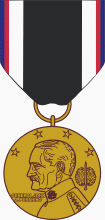 W
WThe Army of Occupation of Germany Medal is a service medal of the United States military which was created by the act of the United States Congress on November 21, 1941. The medal recognizes those members of the United States military who served in the European occupation force following the close of World War I.
 W
WThe Asiatic–Pacific Campaign Medal is a United States military award of the Second World War, which was awarded to any member of the United States Armed Forces who served in the Asiatic-Pacific Theater from 1941 to 1945. The medal was created on November 6, 1942, by Executive Order 9265 issued by President Franklin D. Roosevelt. The medal was designed by Thomas Hudson Jones; the reverse side was designed by Adolph Alexander Weinman which is the same design as used on the reverse of the American Campaign Medal and European-African-Middle Eastern Campaign Medal.
 W
WThe Butler Medal, also known as the Colored Troops Medal, was a military decoration of a unit of the United States Army which were issued in 1865. The medal was commissioned by Major General Benjamin Butler and was intended to recognize meritorious or heroic acts of bravery performed by African American soldiers at the Battle of Chaffin's Farm and New Market Heights. Fourteen African Americans had earned the Medal of Honor in that engagement, but Butler wished to further recognize his African American troops involved in the battle, and he paid for the Butler Medals out of his personal funds.
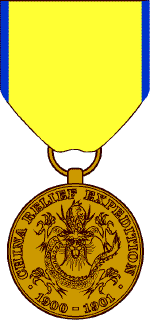 W
WThe China Campaign Medal is a decoration of the United States Army which was created by order of the United States War Department on January 12, 1905. The medal recognizes service in the China Relief Expedition which was conducted by the United States Army at the turn on the 20th century during the Boxer Rebellion.
 W
WThe China Relief Expedition Medal was a decoration of the United States military which was issued to members of both the United States Navy and the United States Marines for service in the China Relief Expedition between 1900 and 1901 during the Boxer Rebellion. The medal was authorized by General Orders of the Department of the Navy on June 27, 1908. General Order 81 established the medal authorized for Naval personnel while General Order 82 authorized the medal for the Marine Corps.
 W
WThe Cold War Victory Medal is both an official medal of the U.S. National Guard and an unofficial military medal of the United States. It is awarded by the U.S. states of Louisiana and Texas, and in ribbon form only by the State of Alaska. In the medal's unofficial capacity it can be purchased, but not worn in uniform. It may be worn by any member of the United States military, or civilian employees of the federal government, who served in their positions honorably during the years of the Cold War, defined as lasting from September 2, 1945 to December 26, 1991.
 W
WThe Cuban Pacification Medal (Navy) is a military award of the United States Navy which was created by orders of the United States Navy Department on 13 August 1909. The medal was awarded to officers and enlisted men who served ashore in Cuba between the dates of 12 September 1906 and 1 April 1909, or who were attached to a specific number of ships, for the Cuban Pacification.
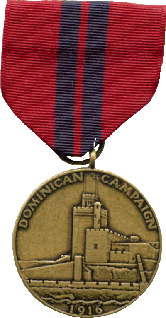 W
WThe Dominican Campaign Medal is a military decoration of the United States Navy and United States Marine Corps which was created on December 29, 1921. To be awarded the Dominican Campaign Medal, a servicemen must have performed active military duty in the Dominican Republic between the dates of May 5 and December 4, 1916.
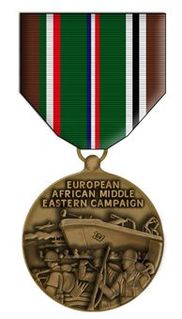 W
WThe European–African–Middle Eastern Campaign Medal is a military award of the United States Armed Forces which was first created on November 6, 1942 by Executive Order 9265 issued by President Franklin D. Roosevelt The medal was intended to recognize those military service members who had performed military duty in the European Theater during the years of the Second World War.
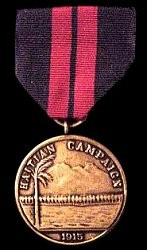 W
WThe Haitian Campaign Medal was a United States Navy military award which was first established on June 22, 1917, and again on December 6, 1921.
 W
WThe Humanitarian Service Medal (HSM) is a military service medal of the United States Armed Forces which was created on January 19, 1977 by President Gerald Ford under Executive Order 11965. The medal may be awarded to any member of the United States military who distinguishes himself or herself by meritorious participation in specified military acts or operations of a humanitarian nature.
 W
WThe Inherent Resolve Campaign Medal is a United States Department of Defense service award and campaign medal. The medal was established by Executive Order on 30 March 2016 by U.S. President Barack Obama. The medal may be awarded to members of the U.S. Army, Navy, Marine Corps, Air Force, and Coast Guard, for service in Iraq, Syria, or contiguous waters or airspace retroactively from 15 June 2014 to a date yet to be determined. Service members who were awarded the Global War on Terrorism Expeditionary Medal for service that is now covered by the Inherent Resolve Campaign Medal may make application to be awarded the Inherent Resolve Campaign Medal in lieu of the Global War on Terrorism Expeditionary Medal. No service member will be entitled to the Global War on Terrorism Expeditionary Medal and Inherent Resolve Campaign Medal for the same action, time period, or service.
 W
WThe Iraq Campaign Medal (ICM) is a military award of the United States Armed Forces which was created by Executive Order 13363 of U.S. President George W. Bush on 29 November 2004, and became available for general distribution in June 2005. The medal was designed by the U.S. Army Institute of Heraldry and was awarded during the Iraq War, from 19 March 2003 to 31 December 2011.
 W
WThe Korea Defense Service Medal (KDSM) is a military service medal of the United States Armed Forces that was first created in 2002 when it was signed into law by President George W. Bush. The bill to create the proposal was introduced and championed by Rep. Elton Gallegly (R-CA) and Sen. Jeff Bingaman (D-NM). Several designs for the medal were proposed. The selected design was done by John Sproston.
 W
WThe Korean Service Medal (KSM) is a military award for service in the United States Armed Forces and was established November 8, 1950 by executive order of President Harry Truman. The Korean Service Medal is the primary US military award for service or participation in operations in the Korean area between June 27, 1950 and July 27, 1954.
 W
WThe Kosovo Campaign Medal (KCM) is a military award of the United States Armed Forces established by Executive Order 13154 of President Bill Clinton on May 3, 2000. The medal recognizes military service performed in Kosovo from March 24, 1999 through December 31, 2013.
 W
WThe Maryland World War I Service Medal was authorized for issue to citizens of the state of Maryland who volunteered for and served in either the Army or Navy of the U.S. during World War I. The state legislature authorized this medal on 13 April 1922.
 W
WThe Mexican Service Medal is an award of the United States military for service in Mexico from 1911 to 1919.
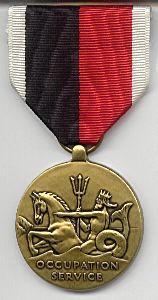 W
WThe Navy Occupation Service Medal is a military award of the United States Navy which was "Awarded to commemorate the services of Navy, Marine Corps and Coast Guard personnel in the occupation of certain territories of the enemies of the U.S. during World War II" and recognized those personnel who participated in the European and Asian occupation forces during, and following World War II. The medal was also bestowed to personnel who performed duty in West Berlin between 1945 and 1990.
 W
WThe Nicaraguan Campaign Medal is a campaign medal of the United States Navy which was authorized by Presidential Order of Woodrow Wilson on September 22, 1913. A later medal, the Second Nicaraguan Campaign Medal was authorized by an act of the United States Congress on November 8, 1929. The two medals were considered two separate awards, with the original medal being commonly referred to as the First Nicaraguan Campaign Medal.
 W
WThe Nuclear Deterrence Operations Service Medal is a service medal of the United States Air Force established on 27 May 2014. The medal recognizes service by personnel in various career fields who have served in units involved with national strategic nuclear deterrence operations. Officer and enlisted personnel in the Active, Air Force Reserve, and Air National Guard communities are eligible for this medal. Eligible service is retroactive from 26 December 1991.
 W
WThe Philippine Campaign Medal is a medal of the United States Armed Forces which was created to denote service of U.S. military men in the Philippine–American War between the years of 1899 and 1913. Although a single service medal, the Philippine Campaign Medal was issued under separate criteria for both the United States Army and the U.S. Navy.
 W
WThe Philippine Congressional Medal was a service medal of the United States Army which was established by the United States Congress on 9 July 1906. The medal recognized those soldiers who had enlisted in the United States Army for the purpose of the serving in the Philippine–American War.
 W
WThe Remote Combat Effects Campaign Medal (RCECM) is a United States Air Force campaign medal established on 22 May 2019. The medal recognizes air force personnel, "in non-deployed status who directly participated in a U.S. Department of Defense (DoD) combat operation from a remote location.
 W
WThe Sampson Medal is a commemorative medal of the United States Navy for service in the Spanish–American War. The medal was authorized by an Act of Congress in 1901. The medal was awarded to those personnel who served on ships in the fleet of Rear Admiral William T. Sampson during combat operations in the waters of the West Indies and Cuba. The Sampson Medal was also known as the Medal Commemorating Naval Engagements in the West Indies or West Indies Naval Campaign Medal, not to be confused with the West Indies Campaign Medal which was a separate award. A similar commemorative decoration was the Dewey Medal, considered senior to the Sampson Medal.
 W
WThe Second Nicaraguan Campaign Medal is a campaign medal of the United States Navy which was authorized by an act of the United States Congress on 8 November 1929. The Second Nicaraguan Campaign Medal was awarded for service during operations in Nicaragua from 1926 to 1933, during the Nicaraguan civil war and the subsequent occupation. An earlier campaign medal, the Nicaraguan Campaign Medal, was awarded for service in Nicaragua 1912.
 W
WThe Southwest Asia Service Medal is a military award of the United States Armed Forces which was created by order of President George H.W. Bush on March 12, 1991. The award is intended to recognize those military service members who performed duty as part of the Persian Gulf War and for a time thereafter. The medal was designed by Nadine Russell of the Army's Institute of Heraldry. The colors of the ribbon are tan, representing sand, with the black, white, red, blue, and green colors symbolizing the colors of coalition countries' national flags.
 W
WThe Spanish War Service Medal was a United States military medal of the U.S. Army which was established by an act of the U.S. Congress on 9 July 1918. The medal recognizes those members of the Army and of the U.S. Volunteers who performed active duty during the Spanish–American War, but did not qualify for the Spanish Campaign Medal.
 W
WThe Texas Cavalry Service Medal is the ninth-highest campaign/service award that was issued to a service member of the Texas Military Forces.
 W
WThe World War I Victory Medal was a United States World War I service medal designed by James Earle Fraser.
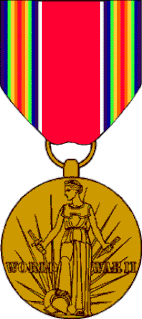 W
WThe World War II Victory Medal is a service medal of the United States military which was established by an Act of Congress on 6 July 1945 and promulgated by Section V, War Department Bulletin 12, 1945.
 W
WThe Yangtze Service Medal is a decoration of the United States military which was created in 1930 for presentation to members of the United States Navy and United States Marine Corps. The Yangtze Service Medal is awarded for service in the Yangtze River Valley between the dates of September 3, 1926 and December 31, 1932, a period of significant unrest in the region.